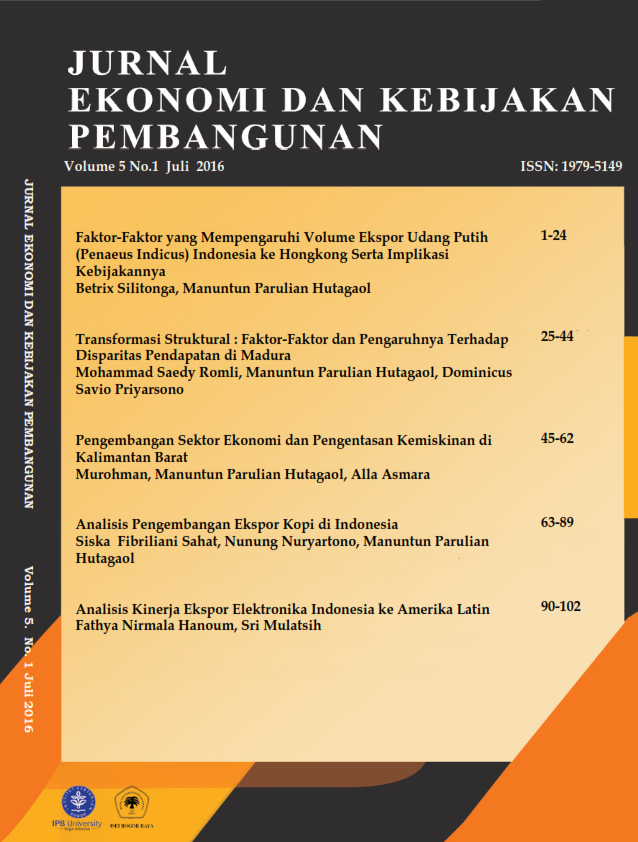ANALISIS PENGEMBANGAN EKSPOR KOPI DI INDONESIA
Abstract
This study aims to analyze recommendations that Indonesia could undergo to increase it’s coffee export performance through factors influencing it’s coffee export growth driver. The analysis using export decomposition showed that since 1994-2013, Indonesian coffee export has been dominated by commodity (grean bean). Export in the form of commodity is fragile regarding it’s volatile price in the international market. This lead to recommend higher processed coffee incorporated in Indonesian coffee export structure. At the same time, regarding the characteristics of the product, the diversification of Indonesian coffee product from green bean to coffee extract is in parallel with the destination country. Gravity model on top three destination countries for Indonesian coffee extract, namely Phillipines, China and Lebanon suggest that supply side, trade agreement and currency are the most influencing factors to trade, and that distance plays insignificant role.
References
Zarzoso IM, Lehman FN. 2003. Augmented Gravity Model: An Empirical Application to Mercosur-European Union Trade Flows. Journal of Applied Economics VI (2): 291-316.
Holton R. 2000. Globalization Culture’s consequences. Annals of the American Academy of Political and Social Science. Vol. 570., Dimensions of Globalization: Sage Publication, Inc.
,2011. The Coffee Exporter’s Guide THIRD EDITION. International Trade Center. Geneva
, 2014. World Coffee Trade (1963-2013): A review of the markets, challenges and opportunities facing the sector. International Coffee Organization. Presented in International Coffee Council 112th session. London, UK
Amiti F. 2007. An anatomy of China’s Export Growth. IMF
Amurgo-Pacheco, Pierola. 2008. Patterns of Export Diversification in Developing Countries. Research Working Paper 4473. World Bank.
Firdaus M. 2011. Aplikasi Ekonometrika untuk Data Panel dan Time Series. Bogor: IPB Press.
Gujarati, Damodar. 2007. “Dasar-dasar Ekonometrika”. Erlangga, Jakarta
Gunadi. 2007. Social Impact of Coffee Crisis on the Pasemah coffee farmers in South Sumatera. MPRA Paper No. 12624, posted. http://mpra.ub.uni-muenchen.de/1 2624/ [9. January 2009].
Hutabarat B. 2010. World Market Condition and It’s Impact in the Performance of National Coffee Industry. Indonesian Journal of Agriculture 3(1), 2010 : 51-59
Ottaway A. 2007. A Rapid Assesment of the Specialty Coffee Value Chain in Indonesia. US Agency for International Development. A Project Implemented by Development Alternatives, Inc. USAID Indonesia
Ponte, S. 2002. The ‘Latte Revolution’? Regulation, Markets and Consumption in the Global Coffee Chain. Journal of World Development Vol. 30, No. 7, pp. 1099–1122. Elsevier Science Ltd. Printed in Great Britain
Tsivadze. 2011. Export Diversification in Georgia :Intensive and Extensive Margin. Master Thesis. International School of Economics at Tbilisi State University. Georgia
Wendelspiess, R. 2010. Firm Response to Advocacy Campaigns - A Case Study into How Campaigns Stimulate Organizational Change. Dissertation of the University of St. Gallen, Graduate School of Business Administration, Economics, Law and Social Sciences, Switzerland.
Authors

This work is licensed under a Creative Commons Attribution-NonCommercial-ShareAlike 4.0 International License.
The authors who publis article(s) in Jurnal Ekonomi and Kebijakan Pembangunan have to understand and agree that the copyright of article published is owned by Jurnal ekonomi and Kebijakan pembangunan including to reproduce, distribute and sell this journal to public.





